Key takeaways:
- Gender equality advocacy addresses disparities in economic opportunities, education, and social health, emphasizing the collective benefits of an equitable society.
- Engaging men is essential for gender equality, as it fosters shared responsibility and challenges traditional gender norms.
- Creating inclusive advocacy environments involves listening to diverse voices, fostering respect, and ensuring representation to enhance empathy and understanding.
- Measuring the impact of advocacy efforts through attendance tracking and participant feedback offers valuable insights into the effectiveness of programs and initiatives.
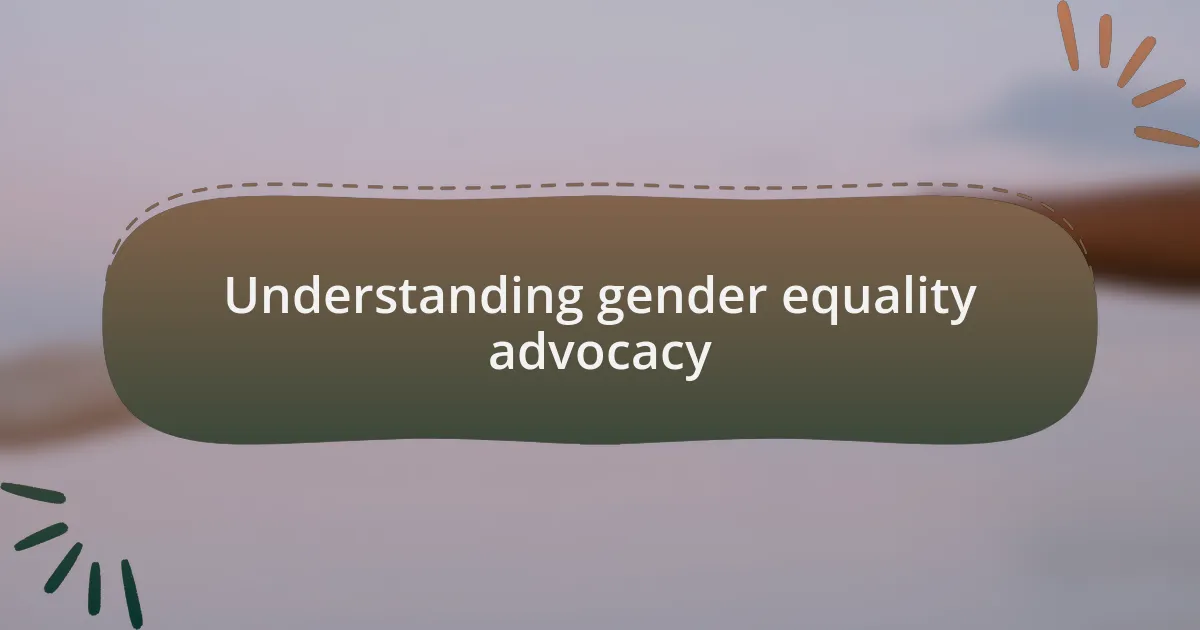
Understanding gender equality advocacy
Gender equality advocacy is essentially about recognizing and addressing the disparities that exist between genders in various aspects of life, such as economic opportunities, education, and social health. I remember the first time I really grasped this concept during a community meeting, where a mother shared her struggle to access the same healthcare services as men in her town. It struck me how deeply these inequalities can affect lives and relationships, fostering a commitment within me to advocate for change.
One might wonder, why should we all care about gender equality? For me, the answer lies in the collective benefit that a more equitable society brings; when everyone, regardless of gender, has equal opportunities, we can unlock a wealth of potential. I often think about how diversity drives innovation. What if the next great idea is sparked by a woman who hasn’t had the chance to shine due to systemic inequalities?
Lastly, understanding gender equality advocacy requires emotional depth. It’s more than just statistics; it’s about real people with real stories and dreams that often remain unrealized. I’ve witnessed the transformative power of advocacy events where individuals share their experiences. It’s in these moments that I realize how advocacy is not just a cause—it’s a movement powered by a shared desire for a just world.
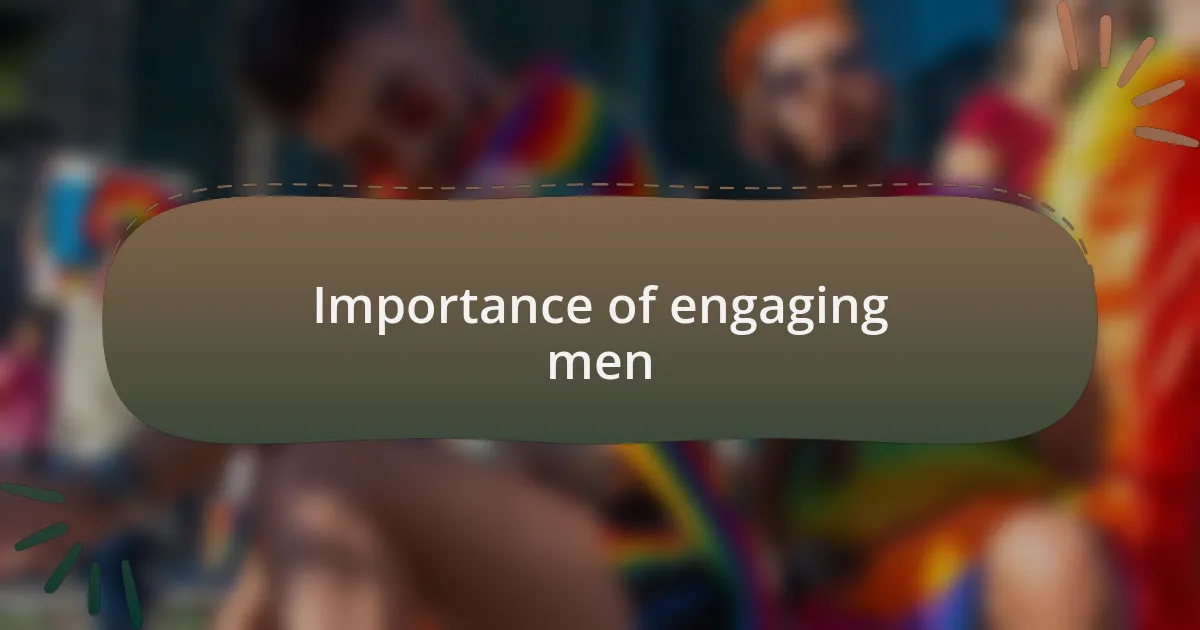
Importance of engaging men
Engaging men in gender equality advocacy is crucial, as it fosters collaboration and shared responsibility. I’ve seen firsthand how men who champion gender equality become role models in their communities, inspiring others to join the cause. It challenges the notion that this is solely a women’s issue; instead, it shows that all genders have a stake in creating a fairer world.
When I think about the impact of involving men in advocacy, I recall a workshop I attended where participants explored how gender norms affect everyone. A man shared his experience of feeling pressured to conform to traditional masculine ideals, which hindered his ability to express vulnerability. This discussion opened my eyes to how advocating for gender equality can benefit men too, allowing them to break free from restrictive stereotypes.
Moreover, when men actively participate in these conversations, it amplifies the message that gender equality is essential for societal progress. I often ask myself: what would our communities look like if men felt empowered to speak out against injustice? The potential for change is immense, and it’s through these collective efforts that we begin to truly reshape our understanding of equality.
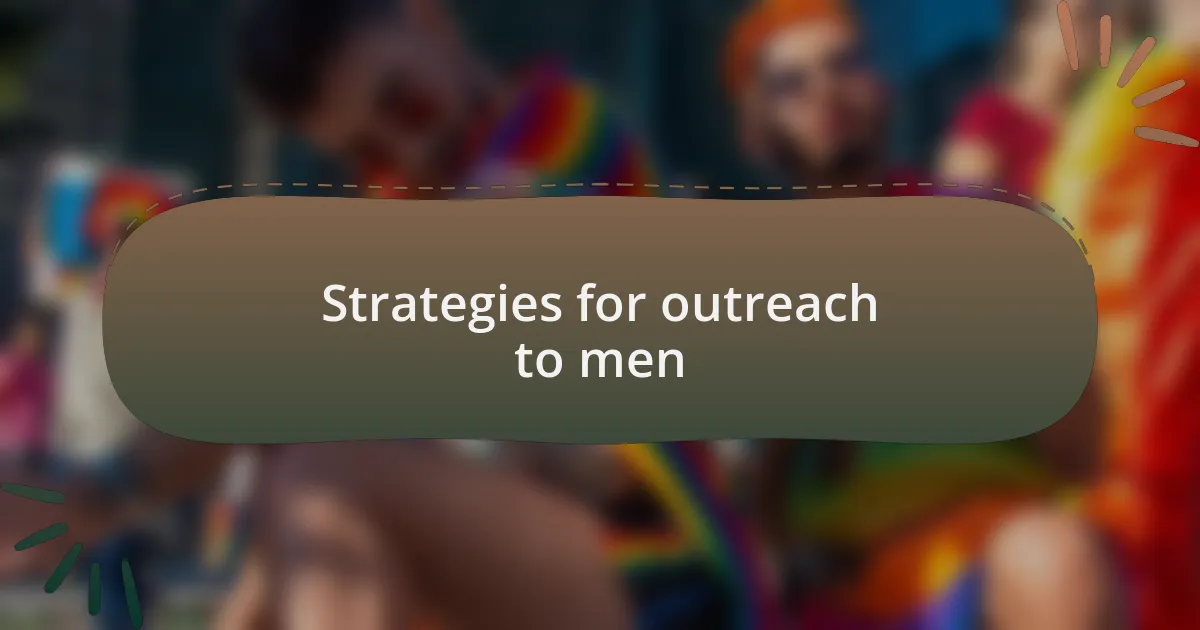
Strategies for outreach to men
One effective strategy for reaching out to men involves creating safe spaces for open dialogue. I remember organizing a roundtable discussion where men could express their thoughts and feelings about gender roles without judgment. This setting allowed participants to confront their own biases and sparked engaging conversations about how they can contribute to gender equality in their everyday lives.
Another approach is to leverage male allies in your advocacy campaigns. From my experience, when male leaders openly support gender equality initiatives, it encourages other men to follow suit. I once witnessed a corporate leader publicly endorse a gender balance program, which not only boosted employee morale but also prompted other organizations to reassess their policies. It’s powerful to see how one man’s voice can influence the broader narrative.
Lastly, using storytelling as a tool can create an emotional connection. Sharing relatable experiences from men who have positively impacted gender equality can inspire others to take action. I often reflect on a story shared by a father who advocated for equal parental leave policies. His personal journey resonated deeply with many in the audience, driving home the idea that gender equality benefits families and society as a whole. How can we harness the power of these personal stories to ignite passion in others? This kind of narrative makes the movement feel reachable and real.
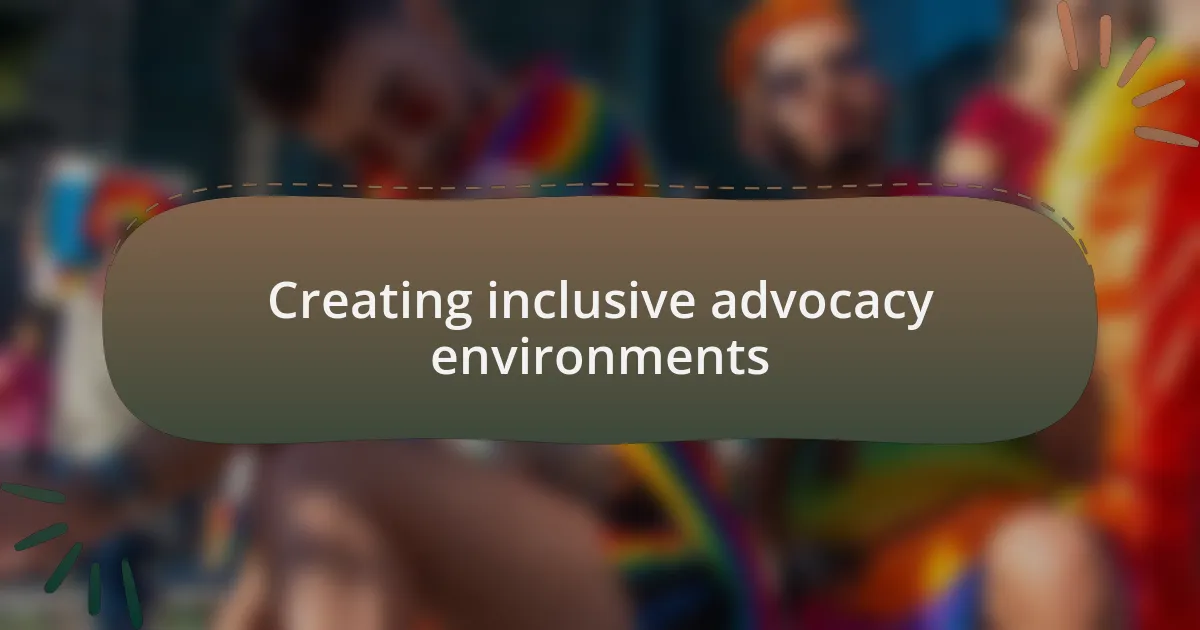
Creating inclusive advocacy environments
Creating an inclusive advocacy environment starts with actively listening to diverse voices. In my experience, facilitating workshops where participants share their perspectives has led to surprising insights. For instance, I recall a session where both men and women candidly discussed their experiences with gender stereotypes, resulting in a richer understanding of each other’s viewpoints. This exchange helped create a sense of community rooted in empathy.
Equally important is fostering a culture of respect and openness. I vividly remember a project where we established ground rules that encouraged everyone to speak up without fear of backlash. The moment one contributor shared their struggle with balancing work and family responsibilities, it opened the floodgates for others to share similar experiences. I realized that when individuals feel safe to communicate, it cultivates an atmosphere where advocacy can thrive.
Furthermore, I believe that representation matters in these spaces. When I attended a panel discussion featuring male advocates alongside women leaders, it struck me how impactful it was for others to see men championing gender equality. It posed a question that often lingers—how many are willing to step out from behind the shadows and lift up this cause? By showcasing diverse leaders, we not only broaden our advocacy reach but also inspire others to recognize their role in the movement.
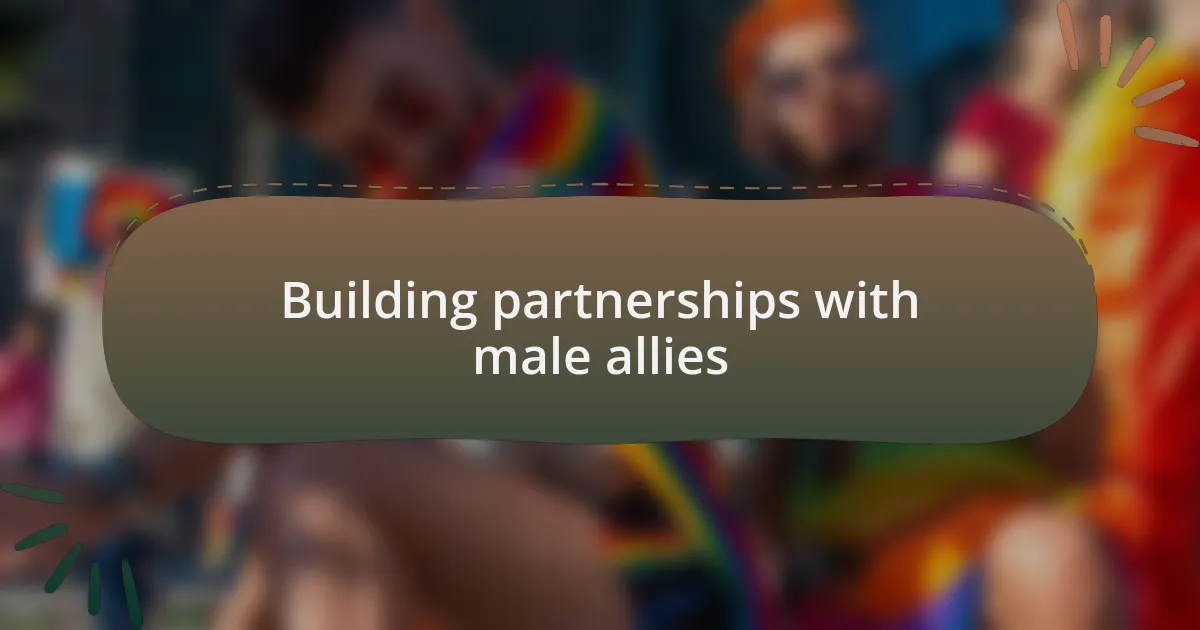
Building partnerships with male allies
Building meaningful partnerships with male allies requires trust and open communication. I’ve had the pleasure of collaborating with men who are genuinely passionate about gender equality. In one memorable partnership, we co-hosted a discussion forum, and it was fascinating to see how men often expressed a desire to support but felt unsure of how to contribute effectively. It reminded me of just how vital it is to create spaces where they feel welcomed and empowered to engage.
One key aspect is ensuring that male allies understand their role in the advocacy space. I once participated in a mentorship program where male mentors were paired with women mentees. This framework not only broke down barriers but also allowed men to see firsthand the challenges women face. I distinctly remember a male mentor sharing his own emotional awakening after listening to the experiences of his mentee. This kind of connection can ignite a powerful commitment to advocacy, raising the question: how can we facilitate more of these transformative experiences?
Moreover, celebrating the successes of male allies can reinforce their commitment. In my experience, I’ve seen how recognizing their efforts in public forums, whether through awards or commendations, fosters a sense of accountability and pride. It’s not just about acknowledging their actions; it’s about building a narrative where they see themselves as integral players in the fight for gender equality. How might we redefine success in advocacy to include male contributions, ensuring they feel valued and recognized?
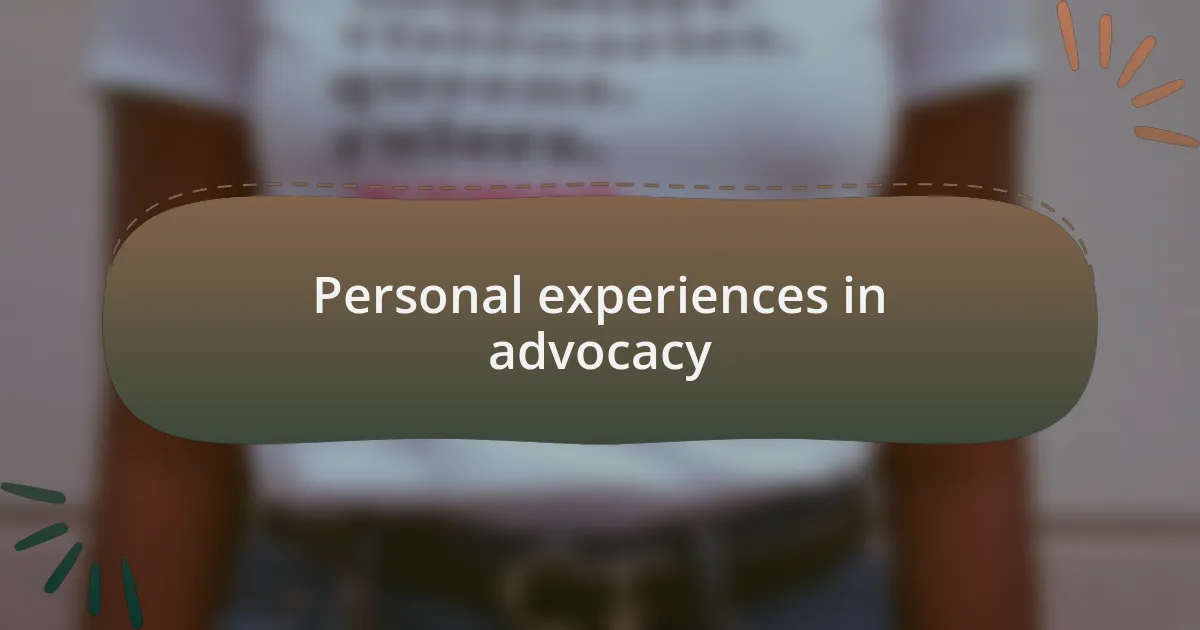
Personal experiences in advocacy
While engaging in advocacy, I’ve encountered moments that profoundly shaped my perspective. One particularly eye-opening experience was during a community event where I led a workshop aimed at educating men about gender equity. As I shared stories and statistics, I noticed the initial skepticism on some faces transform into genuine curiosity. It struck me how important it is to create a safe space where men can express their uncertainties and learn without judgment.
I recall a time when I attended a panel discussion focused on men’s roles in promoting gender equality. One of the male speakers shared his unexpected emotional response to a woman’s story about workplace harassment. His vulnerability caught many in the audience off guard, myself included. It made me realize how impactful storytelling can be; it bridges the gap between experiences and fosters empathy. How often do we allow personal testimonies to humanize statistics in advocacy spaces?
The journey of advocacy has also taught me about the power of small gestures. For instance, during a follow-up meeting with a male ally, he expressed how a simple acknowledgment of his contributions motivated him to take on more responsibilities. This resonated deeply with me—recognition is a potent tool that can fuel continued engagement. It begs the question: how can we build a culture where appreciation for contributions becomes the norm, empowering everyone involved in the advocacy for gender equality?
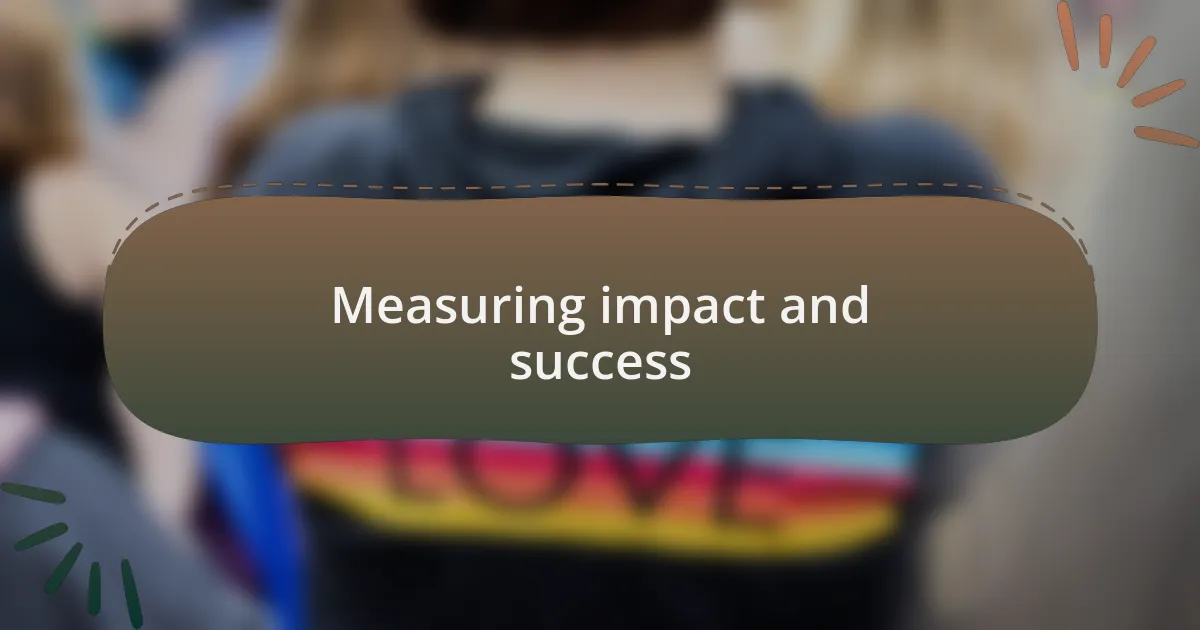
Measuring impact and success
Measuring the impact of advocacy efforts can often feel elusive, yet I believe in the importance of tangible metrics. For instance, after a program aimed at encouraging men’s participation in gender equality discussions, I tracked how many participants returned for subsequent events. This simple act of tracking attendance not only revealed a growing interest but also fostered a sense of community among them. Can you imagine the difference that sustained engagement can make over time?
Another valuable method I’ve employed is gathering feedback through surveys or informal conversations. I recall a particular session where I asked attendees to share their takeaways anonymously. The range of insights was enlightening—some felt empowered to speak up in their workplaces, while others were inspired to start their own initiatives. How can we ignore the voices of those directly involved? Their stories not only serve as valuable data but also highlight the emotional connections formed during advocacy.
Lastly, I find that partnerships with local organizations amplify the assessment of success. Collaborating with a community group provided an opportunity to measure changes in public attitudes and behaviors towards gender equality over time. When we engage with these organizations, are we not also creating a ripple effect that extends our reach? By examining shifts in perceptions and actions, we can better understand the broader impact of our advocacy.